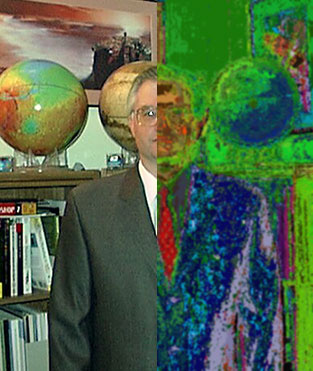The Difference Between True Color, False Color and Pseudo Color
As you look around this web site you will see numerous color images of Mars. However, none of these are true color images of Mars. While some images are close to what you might see, that is an artistic coincidence. Coloring can be defined as falling into one of three categories:
- Natural or true color
- False color
- Pseudo color
Natural or True Color
The first type of color is true or natural color. This is the type of color you get with your typical home camera and is what you would see if you were to observe the target first hand with your own two eyes.
False Color
In a false color image, the colors that are shown are not what you would see if you were to look at the object with your own two eyes. A perfect example of false color is when one or more of the filters being used to take the picture are of wavelengths that are outside the visible portion of the electromagnetic spectrum. The most well known example of this type of image are those that are taken by the Hubble Space Telescope.
For our Mars missions, the cameras are equipped with filters that enable them to take pictures for one or more specific wavelengths. By equipping the camera with red, green, and blue filters in the band of visible light, a false color image can be constructed in order to approximate the true colors of Mars. For some cameras, like the Mars Global Surveyor Wide Angle camera, only two filters are available. Because only red and blue are available, the green component must be extrapolated. This makes constructing a true color image even trickier.
Pseudo Color
The final type of color is known as pseudocolor. My first color art of Mars made based on an image from the Mars Global Surveyor mission used this coloring technique (see Genesis). Pseudocolor begins with a single band of data or data from one single filter. This means that for a single pixel, there are 256 possible values. The next step is to take each of these values and map them to a specific color thus creating a color image.
Below is an example of the difference between a true color picture and a pseudo color picture. On the left is the original true color image. On the right is a pseudo color version that was created by mapping an alternative palette of colors onto the image.


